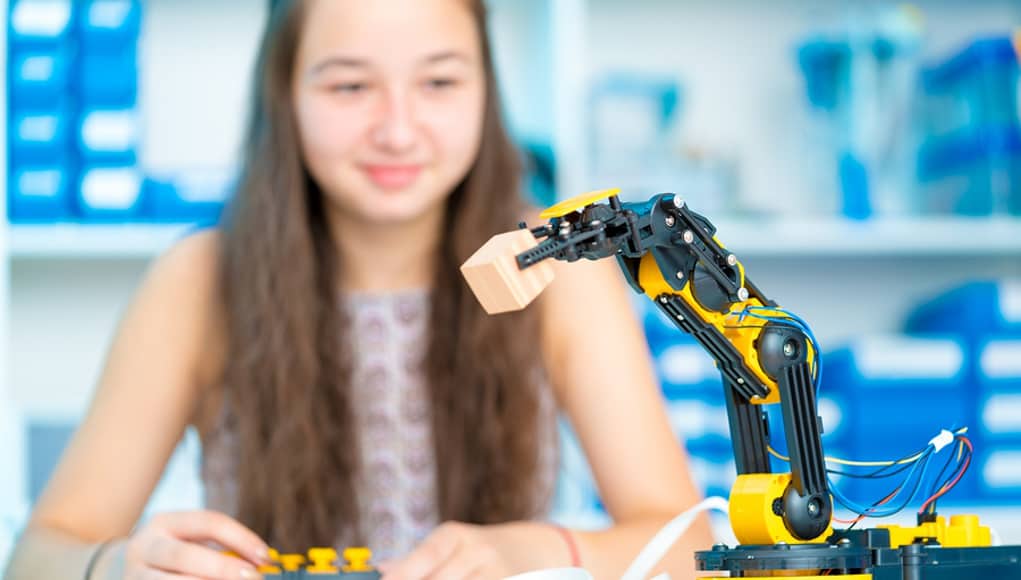Plugging into the New, 21st-Century Vision of Learning

By Paula Dillon
Kieran Egan and Chris Sarli and their team lead a group that services laptops and provides technology support for the entire district. The Research Development and Innovation Team has researched different schools around the world, determined key trends in self-directed learning, and come together to develop solutions to problems they want to address in the district. The iCreate Lab staff works to develop products and innovations that serve local businesses’ needs.
Now, you may have thought Chris and Kieran’s team and the others here were managed by our educators or building staff—but they are actually led by our students.
As one of the Partnership for 21st Century Learning (P21)’s Exemplar Schools, we continually seek to bring the most transformative 21st-century learning practices to our classrooms—particularly those that rely on student empowerment and self-directed learning. This mission began once we realized that youth across our district did not often see the connections between what they learned and observed outside the classroom.
At that moment, we realized we needed to deliver education with students, not to them. And we needed to shift the goals of learning altogether, advising students that it is OK to make mistakes in order to grow.
As a result of this shift, we’ve seen a transformation in a variety of subject areas including STEAM and the Humanities. For example, these range from the maker spaces that now span our district and serve as new learning environments to the student-led iCreate Lab and Research Development and Innovation Teams. Also, through collaboration with our local universities, such as Brown University, Rhode Island School of Design, and Massachusetts Institute of Technology, as well as our extensive partnership with the Barrington Education Foundation, our STEAM programs provide our students with the industry-aligned skills they need to excel in the workforce.
School leaders can leverage new research and standards to help their educators make this transition in their classrooms. The Next Generation Science Standards have provided teachers with the requisite training to bring this shift to inquiry-based instruction to their classrooms and use the assessments needed to effectively measure their students’ learning gains. Performance expectations are built right into these standards, ensuring that teachers understand how to link science standards and core concepts across the other disciplines.
Educators can leverage deeper learning competencies that enable students to build on a strong foundation of academic knowledge—and encourage the development of critical thinking, collaboration, creativity and communication (the 4C’s). Then, in the process, students learn how to learn.
This shift to inquiry-based, student-directed learning in our STEAM subjects serves as an example of the new vision of 21st-century learning here in Barrington. As school leaders consider how to bring such a vision to their buildings, they can consider these initial steps:
- Proactively solicit input from your students on how to strengthen the link between their experiences in the classroom and in the outside world; determine focus areas such as STEAM
- Focus on providing students with the broad set of skills (ranging from problem solving and critical thinking to communication) to transfer knowledge across content areas
- Establish opportunities for students to apply these skills in authentic situations that address real-world problems across their building and their community
- Build key relationships with cross-sector partners such as community organizations, universities, and businesses to offer students an industry-aligned curricula and provide them with the tools to succeed in college and career.
This is only the beginning. It’s important to promote collaboration across schools, districts, and even states to disseminate promising practices or strategies to overcome some of the obstacles around 21st-century learning.
P21 makes that possible, helping to build a network of like-minded schools that collectively come together—whether virtually or in-person like at last month’s Closing the Skills Gap forum in Washington D.C.—to chart the path forward for 21st-century learning. From the forum, we’ve gained invaluable insight, for example, on how to bring experiential learning to our district and explore the possibility of an International Baccalaureate program.
Their “Skills for Today” week at the end of April will convene this network as well as empower other schools and their students from across the country to explore how to implement this new vision—from cradle to career.
From there, we hope that more students like Chris Sarli and Kieran Egan can plug into this new vision of 21st-century learning across a wide range of schools.
For more, see:
- Shifting Paradigms to Respond to the Demands of a Global World
- 15 Moonshots in Education
- Infographic | Connecting Educators Globally
Paula Dillon is Assistant Superintendent at Barrington Public Schools in Barrington, Rhode Island. Follow her on Twitter: @paula_dillon.
Stay in-the-know with all things EdTech and innovations in learning by signing up to receive the weekly Smart Update.


0 Comments
Leave a Comment
Your email address will not be published. All fields are required.